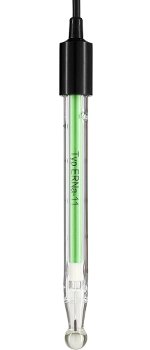SODIUM ION SELECTIVE ELECTRODE ERNa-11
The combination glass sodium electrode ERNa-11 is designed for direct measurements of activity or concentration of the sodium ions in aqueous solutions and in many water-organic mixtures. The measurements may be done both in laboratory and in industrial conditions. In laboratory they may be done by direct measurement or using any of the techniques based on the growth of sodium ion concentration in the sample. The electrode has a glass body and a round glass ion selective membrane. Using 3, easy accessible, ceramic diafragms (electrolytic junctions) ensures a good contact between the reference half cell and the measured solution, what stabilizes the readouts and increases the reliability of the electrode work. In the upper part of the electrode body there is a hole, it enables refilling the reference electrolyte. As the reference electrolyte a mixture of ammonium nitrate and ammonium chloride is used. To eliminate additional interferences a low noise cable is used. The typical applications of the sodium electrode are measurements in boiler water, distilled water, industrial sewage, all kinds of water in biologic samples (ex. blood) food products and soil samples etc.
Technical data
| Measuring range for immersion measurements | 10-6 ÷ 1 mol/l Na+ 0.023 ÷ 23000 ppm Na+ |
|---|---|
| Measuring range for in flow measurements | 10-7 ÷ 1 mol/l Na+ 10-3 ÷ 23000 ppm Na+ |
| Temperature range | 0 ÷ 80 °C |
| Acceptable pH range | 8 ÷ 12 pH |
| Characteristic slope | 57 ±2 mV/pNa+ |
| Response time | 30 to 60 s |
| Membrane resistance (in 20°C) | 100 to 300 MΩ |
| Selectivity coefficient | Ag+= 100 H+ = 30 K+ = 1O-2 NH4+ = 10 -4 |
| Reference halfcell | Ag / AgCl |
| Reference solution (SE-03) | 0.1M NH4Cl + 4.0M NH4NO3 |
| Membrane shape | round bulb |
| Electrolytical junction | 3 x ceramic |
| Body diameter | 12 mm ±0.5 mm |
| Body length (without cap) | 120 mm ±5 mm |
| Minimal immersion | 30 mm |
| Maximal immersion | 105 mm |
| Body material | glass |
| Cable cap material | polypropylene |
| Cable length | about 1 m |
| Connector | BNC-50 |


